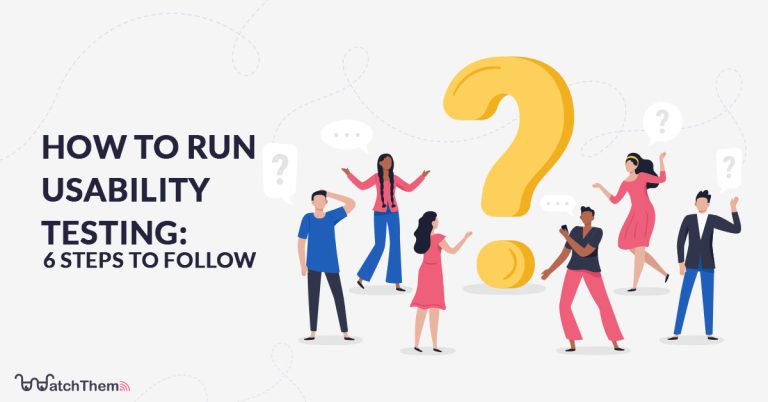Page Contents
Before starting the usability testing process, it is essential for you to have a solid and meaningful strategy and complete data about your users. Having an organized routine will help you to measure the outcomes. This is important if you need to do this process again or see how your changes affect the usability of your product.
In this article, we are going to discuss how to run usability testing. However, keep in mind that it can be very complex. But don’t worry. We will guide you through the whole user testing process step by step.
Let’s start.
Get insights on your customers and make better decisions. We help you understand how your users behave, why they do what they do, and how to optimize your conversion processes. You will get it all by just signing up here.


What Is Usability Testing And How Is It Conducted?
Usability testing is the process of making sure that a product or service is working fine by testing it by real users. To make this definition work, you need to have some professionals in this matter and some users to work with your product. These professionals are called moderators. They will do the test and gather the information you need to make decisions. As it is mentioned in this article, there is a big potential in some areas of your product that can be known just by usability testing.
Some matters must be apparent before conducting usability testing. We grouped them into three categories:
- Your goal of performing the process.
- Your resources, including money and time.
- The specific audience that you want to test with.
After clearing out all of the above matters, it’s time to ask this question: “How to conduct a usability test?” We will answer this question in the following parts. You need to prepare and go through some steps for conducting usability testing. So, let’s dive into it without any further talking.
How Do You Prepare for a Usability Test?
Preparation is the key to success in every situation in life. Sometimes it’s not possible to be ready before the event. However, if you have the chance, it’s better to do it. In our case, being prepared for usability testing has some similarities to our next section in which we describe the steps or the question “how to conduct user testing?” But if we want to give you a list, we can go with the items below:
- Have a specific plan.
- Make sure to have a prototype of your product or service.
- Consider devoting enough resources to the process.
- Determine who your audiences are that must do the tests.
- Have a dedicated place for the test with an undisturbed environment.
Now that you know about the preparation, it’s time to see what these six steps are that we’re talking about.
What Software Can Help You With Usability Testing?
Let’s make it clear that using platforms that can gather information about your customers can be super helpful in this process. Here we will talk about one of the best user tracking platforms in the market, WatchThemLive.
WatchThemLive is a platform with lots of features such as heatmaps, session recording, user tracking, and many more. However, our main concentration is on their user tracking service.
This service will do a great job of gathering information about every detailed aspect of your users. You can see where they come from, which device they are using, and even which browser they use to visit your webpage. This will make your goal setting and reaching conclusions much easier for the usability testing of your product.
Make sure to sign up here in case you need a great platform to be beside you in the following steps.
How to Do Usability Testing in Just 6 Steps?
If you want to do proper usability testing, go through the following steps to get your desired outcomes:
1. Creating a Prototype
A prototype is a basic form of your product that can be changed easily within a short period. The primary purpose of a prototype is for testing and show ideas. You can quickly learn new features and ideas from a prototype and if they are not good enough, just change them.
There are many different ways to make a prototype. You can choose one of them according to your specific goal. Here is a list of these ways with brief descriptions:
- Drawing sketches: This is a simple way to put your ideas down on paper and join them together to see the bigger picture. This method is used mainly at the very first steps of the project and can be changed easily.
- Wireframes: An alternative method to sketching is creating wireframes in online apps and connecting them with some wires for further decisions.
- Stroy-telling: Telling stories has been the fastest way to exchange information from the very first days of civilization. You can use this method to see what’s going on with your product and interact with the users.
2. Creating a Test Plan
If you do testing without any previous planning, it won’t work so well. It doesn’t matter if you use user testing best practices or not. The most critical questions that must be asked before starting the process are:
- What is going to be tested in the process?
- How do you measure the results?
When you answer these questions, you know where you are heading, and no surprises will come your way. Make sure to consider these questions at the start of your usability testing.
3. Recruiting Target Users
There are different situations that can lead to various types of recruiting. For example, if you are self-employed and want to test your product, your friends are the best option. Ask them to help you with your project. Another case is when you already have your own customers. You can easily reach out to them and give them some bonuses if they help you in your usability testing.
However, if you are in a big company that can afford to hire users, especially for this matter, it’s best to take help from websites and apps that perform such services.
The most important thing is that your testers must be unbiased. They shouldn’t say stuff just to make you happy or vice versa.
4. Testing Location
Being able to do the process in a dedicated place will have a great effect on the outcome. Doing the test over Skype or other online software has the risk of distraction for your users.
It’s also thoughtful to get help from specialists to supervise the test. One thing that is worth mentioning is that it’s better not to bring your subjects to the company. It can make them uncomfortable or affect their decisions.
5. Running the Test
Testing everything in a warm, friendly environment with infinite time to complete the test would be a mistake. Provide context for your users and remind them to visualize themselves using your app in a real-life environment
It’s also crucial to gratify your audience for devoting their time to assist you. Remind them that the reason you’re conducting these user feedback sessions is to improve the usability of your product to make the best user experience possible.
You must assure them that the test information will be kept secret and no one will find out their identity.
6. Documenting
Write every detail in a report and make sure to add any other changes made further on the road to it. This will allow you to concentrate on the issues that are causing the biggest problems. The areas that need to be improved will become obvious very fast.
Well done, your test process is done. Now that you have the results, it’s time to go over them, again and again, and apply the changes you think will benefit your product.
WatchThemLive is a behavior analytics tool that helps web platforms increase their conversions by giving them a deeper understanding of what their users go through. Make sure to sign up now.
Conclusion
“How to do user testing?” This one specific question is the main reason why we wrote this article. We tried our best to provide you with the information you are looking for. First, we gave you the definition of usability testing, that its main goal is making products better by testing them by the users themselves. Then we went through the process itself: creating a prototype, making a plan, recruiting target users, managing to find a dedicated location, running the test, and finally documenting it.
These are all parts of the answer to the question “how to do a usability test?” Hope it helps you.

